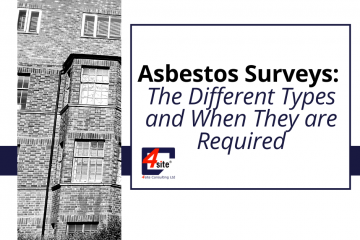The law and dutyholders’ responsibilities
Asbestos is a naturally occurring fibrous material that was widely used in building materials up until 2000 due to its heat resisting and durability properties. Unfortunately, Asbestos is also harmful to health when disturbed fibres are breathed in. As such, the law requires that Asbestos Surveys are carried out on all non-domestic buildings or the common areas of residential flats constructed before the year 2000, in order to help manage and provide accurate information on the location and condition of any possible Asbestos Containing Materials (ACMs). This includes: offices, schools, hospitals and common areas of non-domestic buildings.
Those responsible for such properties, i.e. Property Managers or RMC Directors, have a duty under Regulation 4 of the Control of Asbestos Regulations 2012 to manage Asbestos in non-domestic premises. This means that the regulation does not place any direct duty on landlords of the individual houses or flats but instead on those responsible for the shared areas such as, stairwells, corridors, lifts, boiler rooms, vertical risers, and outhouses.
Asbestos Management Surveys, and in some cases Refurbishment and Demolition surveys, should be used as the primary means of managing Asbestos. If asbestos is present in the building and recommendations are not made to have it removed, yearly re-inspections are required to manage it.
The extent of the works being carried out on a building, will determine which type of Survey will be needed:
Different types of Asbestos Surveys
- Asbestos Management Surveys:
An Asbestos Management Survey is a standard survey that is required on any building built before the year 2000. Its purpose is to locate, as far as reasonably practicable, the presence and extent of any suspect ACMs in the building which could be damaged or disturbed during normal occupancy.
Asbestos Management Surveys will likely involve minor intrusive work as samples will usually be taken to confirm if Asbestos is present.
In cases where access cannot be gained, the area will be marked as no access on the report and presumed asbestos until the Surveyor can gain access at a later date/ in the next re-inspection.
Areas such as lift shafts and electric cupboards will require a professional to help the assessor gain access (a lift engineer or electrician) and this will need to be arranged by the responsible person for the building. Areas inspected should also include: underfloor coverings, above false ceilings (ceiling voids), lofts, inside risers, service ducts and lift shafts, basements, cellars, underground rooms, and undercrofts.
- Asbestos Re-inspection Surveys
It is important to note that having a Management Survey carried out is not the end point in managing any asbestos in the premises. Annual re-inspections are required to update the register of the condition of any ACM changes.
If Asbestos is present and is in a manageable condition, the dutyholder has a responsibility to ensure yearly Asbestos Re-inspections take place, to ensure that their state has not changed. If Asbestos is found to be in a poor condition, or is in an area that will likely be regularly disturbed, then recommendations will be made to have it removed. Generally, it is safer to leave any ACMs and review their condition over time than to have them removed.
- Refurbishment and Demolition Surveys
Management Surveys should be sufficient for simple routine maintenance work, however, where more extensive work is going to be taking place, a Refurbishment and Demolition Survey (R&D Survey) is likely to be required. R&D Surveys are needed to locate and describe, as far as reasonably practicable, all ACMs in the area where refurbishment work will take place (if Demolition is planned, they will cover the whole building).
An R&D Survey will be fully intrusive and involve destructive inspection, as necessary, to gain access to all areas, including those that may be difficult to reach.
If Asbestos is found during the Survey, recommendations will be made to have it removed. Under the Control of Asbestos Regulations 2012, there is a requirement for all Asbestos Containing Materials to be removed, as far as reasonably practicable, before major refurbishment or demolition takes place. This may also be required in smaller refurbishment situations where structural or layout changes are going to be made to a building.
Asbestos Surveys for Contractors
Overall, a management survey with yearly re-inspections (if asbestos is present) should be sufficient for routine maintenance works. However, more extensive refurbishment works or demolition works are likely to require an R&D Survey.
Contractors carrying out any maintenance works will need to know the location and condition of any ACMs in the building. As the dutyholder for the site, it is your responsibility to ensure contractors have access to the sites Asbestos Surveys and the Register, however, it is also their responsibility to ensure they are checking this before starting any works on the building.
The Asbestos Register must be viewed and acknowledged by all contractors before any work commences onsite, to ensure they are aware of any Asbestos present. If you are sending contractors the Asbestos Register by email, you should ask that they reply to the email to confirm they have received this and crucially understood the contents in relation to the works they are doing.


